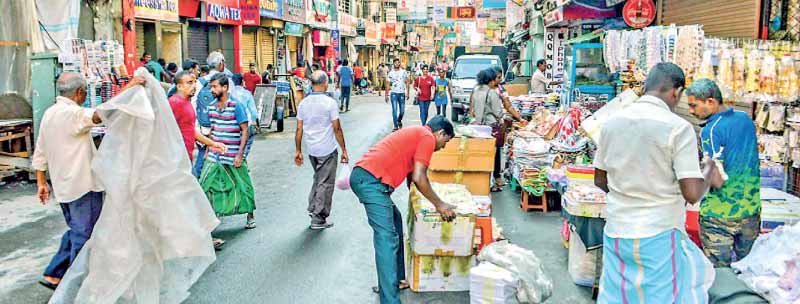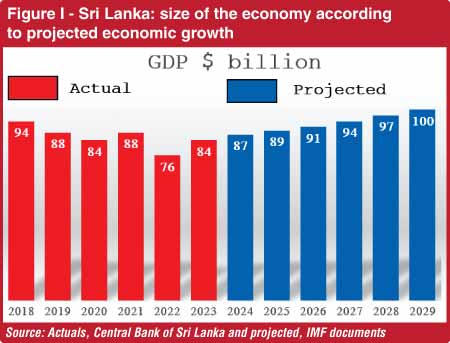Sunday Apr 20, 2025
Sunday Apr 20, 2025
Monday, 23 September 2024 02:10 - - {{hitsCtrl.values.hits}}

Beneath this diabolic calmness on the surface, the economy is dangerously boiling, heating up gradually every moment without an internally built cooling mechanism and ready for eruption like a volcano
|
 AKD should not follow Gotabaya
AKD should not follow Gotabaya
By the time of writing this article on Sunday morning, it seemed that Sri Lankans have chosen the National People’s Power or NPP Presidential candidate Anura Kumara Dissanayake, known as AKD, as their new President for the next five years. As expected, the supporters of the new President are celebrating the victory with over-jubilation in the social media due to the curfew imposed and later extended by the Government of Ranil Wickremesinghe, introduced to voters as Ranil by Wickremesinghe himself.
A similar triumphal environment prevailed in the country when Gotabaya Rajapaksa or Gota was put on the pedestal of presidency by 6.9 million voters five years ago. At street corners, people distributed the traditional milk rice with sweets to passersby. The over-confident Gota made the first grave mistake by announcing that he was a president elected by the Sinhala-Buddhist voters in the South rejecting the rights of the voters in the North and the East to express their free choice at an election. Those voters in that region are made of the minority Hindu-Tamils and those following the Islamic faith. Thus, his reading was that he was not the President of all Sri Lankans but only the majority Sinhala-Buddhists. But within two years, he had to flee the country because he failed to manage the more important factor, the ‘economy stupid’ prudently. It, therefore, behoves on the new President to take note of the grave state of the economy and adopt appropriate policies to fix it as a matter of priority.
State of the economy
What is the economy which the new President has inherited from the outgoing President? On the surface, it is a more orderly economy compared with the chaos-filled one which Sri Lanka had about two and a half years ago. There are no long queues for essential consumer items like fuel, cooking gas, and basic food items. There are no curse-generating power cuts anymore. Foreign exchange is available to users – both consumers and producers – through banking channels. The foreign exchange black market is virtually non-existent. People are enjoying life travelling locally as well as overseas on holidays or pilgrimages.
Economic growth which had fallen to the negative region has made a remarkable turnaround recording slight growth rates but still lower than the economic strength which the country had in 2018. Prices are no more rising at offensive high rates. Exchange rate is stable and has remained so over the past one and a half years. All these good signs are due to the credit of the authorities to harness an extended fund facility from IMF, a generous credit line offered by India, and the strict monetary policy action taken by the Central Bank.
Need for increasing real goods and services
Beneath this diabolic calmness on the surface, the economy is dangerously boiling, heating up gradually every moment without an internally built cooling mechanism and ready for eruption like a volcano that has become active. The IMF program and the associate support from the international community, especially Sri Lanka’s neighbour to the north, India, have stabilised the nominal side of the economy, namely, inflation rate and price level, exchange rate, key factors in the balance of payments and the Government budget, and money growth. This stability is necessary for any economy to place itself on a long-term growth path. In economics, these are related to what is known as the nominal aggregate demand.
What matters for the welfare and prosperity of people is the real side of the economy, represented by the real aggregate supply, where the real goods and services are produced for them to enjoy life. The real side of the economy produces real goods and services – goods that can be consumed directly or used as inputs for further production. For instance, a 5,000-rupee note is not a real good because it cannot be directly consumed or used in its paper form as an input for further production. If anybody wants to enjoy its value, it should be converted to a real good or service.
But, say for example, rice, on the other hand, can be cooked and eaten directly or used for producing, say, rice alcohol. Hence, the welfare and prosperity of people will depend on the quantity of rice and all other such real goods and services that are produced in an economy. We measure the quantity of those real goods and services produced in an economy by compiling an aggregate called the real gross domestic product or real GDP.
Issues with GDP
It is this real GDP which is faltering in Sri Lanka on two counts. First, its annual growth in the foreseeable future is abysmally low. Second, its distribution has been awkward and not inclusive with a larger share going into the hands of a few people, while the majority is enjoying a dismal amount.
Low growth
The projected economic growth is low at around 3% annually over 2024-29 as shown by Figure I, because the contributors to real economic growth have been underperforming in Sri Lanka in the past few years. Real growth comes from real investment represented by the growth in the real physical capital stock, agility and versatility of human capital stock, and the available technical knowhow. For example, to produce a shirt, we need a smart sewing machine and a building that represents physical capital, a versatile and creative operator that represents human capital and good designs that represent technical knowhow. Due to the declining economic growth recorded by Sri Lanka from around 2012 and the economic slump experienced in the last few years, all these factors have grown below what is needed for the economy to record a high economic growth.
This has been aggravated by the negative savings made by the Government – its recurrent or consumption expenditure is more than the revenue – and the cutting of capital expenditure to show statistically that budget deficit is within the target levels. This was the general practice of the Government throughout, but it was liberally used in 2023 to show a mild surplus in the primary account. The budgeted capital expenditure for 2023 was Rs. 1,220 billion. But the actual expenditure was Rs. 657 billion. Hence, the much-publicised primary account surplus in 2023 has been generated by compromising the future economic growth. Hence, to push the economy up, there is a necessity for boosting all these sides simultaneously across all the sectors in the economy, agriculture, industry, construction, and services.
|
 K type growth and unequal distribution of income
K type growth and unequal distribution of income
Throughout the post-independence period, the sharing of the wealth of the country has been awkward and exclusive. Contrary to this ground level outcome, economic justice requires it to be inclusive meaning that economic prosperity should be distributed among people fairly equally. Yet, the richest 20% of the country had appropriated for itself about a half of the country’s income, while the share of the lowest 20% of income earners had been about 5%. The balance 45% of income had been apportioned to the middle class. This has been the usual case, though all the successive Governments had adopted pro-poor income distribution policies. This outcome is bad enough, but the worse has been the ‘K’ type economic development that has taken place in the past few years after the country was hit by COVID-19 pandemic and the unprecedented deep economic crisis thereafter.
Accordingly, when the economy was put on a stable path after getting EFF from IMF and support from friendly nations, the rich moving up on the rising part of letter K became richer and the poor sliding down the falling part, became poorer. This is understandable because it favours physical and financial capital owners, protecting their rights and ignores human capital owners. This is evident from the quantitative target set by IMF conditions for attaining a surplus in the primary account of the Government budget.
The primary account is the components in the budget, namely revenue and the net expenditure excluding the interest payments. Thus, a surplus should be attained without touching interest payments but curtailing the other expenditure which IMF categorises as discretionary expenditure and increasing the revenue or through a combination of both. Therefore, to generate a surplus in the primary account, the Governments are forced to protect the interest payments but cut the payments to the labour. Therefore, in the current model, labour gets less but the rich class owning capital gets more.
The poor becoming poorer
In Sri Lanka, both low- and middle-class income earners are sliding down the declining part of K type growth. How have these categories been driven from pillar to post due to the economic policy packages implemented by the Government? One is the decline in the real wellbeing due to increases in the cost of living. According to the rebased Colombo Consumers Price Index compiled by the Department of Census and Statistics, in January 2021, a family of about four members had to spend Rs. 91,880 a month to buy the basket of consumer goods and services included in the index. But with the acceleration of the inflation rate, this cost has now increased to Rs. 175,490 at end August 2024.
Accordingly, the real income of a family has fallen by 91% during this period unless his income has not increased by the same percentage. For instance, the real income of a middle-income earner who had got Rs. 200,000 a month in January 2021 would have been reduced to Rs. 104,712 by August 2024. In economics, this known as inflation tax.
On top of this, under the new income tax regime where he is taxed not on the real income but on the nominal income, he should pay Rs. 6,000 or 6% on the income above the tax-free threshold of Rs. 100,000. This reduces his usable real income further to Rs. 101,570.
The story does not end here since it is the gross expenditure of the Government which imposes the actual burden on a citizen, as claimed by the 19th century English economist David Ricardo. He said that citizens pay income and indirect taxes to finance today to finance the Government’s gross expenditure. However, when the Government borrows money to finance the budget deficit, people will have to pay taxes in the future to repay that debt. His famous statement was that there is not difference between tax financing and bond financing when it comes to imposing a burden on the citizens. Accordingly, the income earner in this example will have to pay taxes in the current period by way of income taxes and indirect taxes.
In addition, he will carry a future tax liability for the money the Government has borrowed too. When these burdens are calculated by using the numbers in the budget for 2024, on average he should pay an additional sum of Rs. 10,378 in the current period as indirect taxes. Both the income taxes and indirect taxes will reduce his disposable income by Rs. 16,378. Accordingly, his real income further falls to Rs. 96,137. In addition, a contingent liability of Rs. 27,000 should be carried by him arising from his future tax obligations on account of future debt repayments of the government. This reduces this middle-class income earner to a pauper.
Rejection of Ranil’s plea for a second term
This is a sizeable burden that has fallen on the middle-class income earners. Though low-income people do not pay income taxes, they are subject to inflation tax, indirect taxes, and a future tax obligation to repay the Government’s current debt. That has been boiling within them rising to an explosive point. There should have been a social cooling system to appease them. However, when they raised their angry voice, instead of seeking to appease them, they were mercilessly suppressed by the Government led by President Ranil Wickremesinghe. This short-term tactic helped Ranil to keep the Government going.
But it infuriated the people, and this was evident from the results of the Presidential election held on 21 September. Ranil pleaded with voters to give him another term to complete the unfinished job. His main argument was that he brought the economy to order by eliminating queues for fuel, cooking gas and other essential items. This message could not be driven into the heads of voters who had been boiling from within. Their rejection of his plea was an open expression of the deep-rooted anger against his Government and its policies. It seems that this seasoned and mature politician could not read the reality at the ground level where people had been sliding down the declining part of the K-growth model. Since the poor have become poorer and the rich have become richer, the widening income gap has also created social disunity, frustration, and anger among those in the middle and low-income classes. This has been fatal for Ranil’s re-election attempts.
|
AKD should address the issue promptly
The newly elected President Anura Kumara Dissanayake and his associates should take note of this boiling ground situation. AKD has come to power out of the anger of people and he should not commit the same follies as Ranil by not addressing the boiling social tensions beneath the seeming calmness on the surface. If he does not address this issue on a priority basis, surely his reign is also to be short-lived like the one led by Gotabaya Rajapaksa and after him, by Ranil Wickremesinghe.
(The writer, a former Deputy Governor of the Central Bank of Sri Lanka, can be reached at [email protected].)